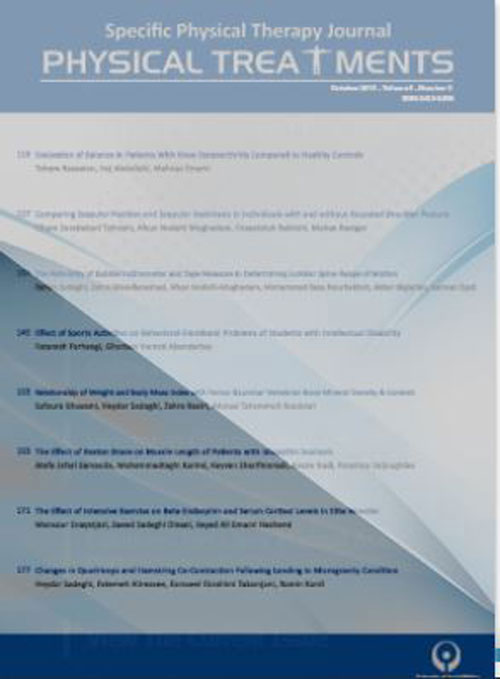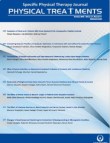فهرست مطالب

Physical Treatments Journal
Volume:9 Issue: 3, Summer 2019
- تاریخ انتشار: 1398/04/10
- تعداد عناوین: 6
-
-
Pages 137-146Purpose
The present study investigated the most appropriate footprint index and its related parameters for the diagnosis of flatfoot, especially in cases with mild deformity.
MethodsIn total, 148 footprints were recorded from 77 young women with flatfoot. Footprints were classified into three groups of mild, moderate, and sever. Footprint indexes included Sztriter-Godunov (KY), Clarke’s Angle (CA), Chippaux-Smirak Index (CSI), and Staheli (ST) indexes. The mentioned indexes and their relevant parameters were calculated on the footprints in the aforementioned groups. Exploratory factor analysis was used to identify proper components for the diagnosis of flatfoot. By multivariate analysis of variance, between-group differences were assessed. A Chi-squared test was used to identify the most accurate index for the diagnosis of mild flatfoot.
ResultsExploratory factor analysis based on the parameters of footprint indexes identified three essential components. Two identified components were based on the 6 parameters of CSI, KY, and ST indexes in moderate and sever footprints. The third component was related to footprints with mild grading and was composed of three extracted parameters from midfoot region. Moreover, the linear combination of the three last parameters suggested a significant difference between three groups (P<0.01). Eventually, KY index could identify the highest number of flatfoots in the mild group (P=0.000).
ConclusionStudy findings revealed that indexes in which parameters were extracted from midfoot region could be suitable for the diagnosis of mild flatfoot. KY index’s parameters were extracted from midfoot. Considering that KY could identify several remarkable mild flatfoots in comparison with other indexes, we can introduce it as a proper index.
Keywords: Flatfoot, Footprint index, Sztriter-Godunov, Clarke’s angle, Chippaux-Smirak, Staheli -
Pages 147-152Purpose
The body core facilitates the transition of forces and moments between the upper and lower extremities in every movement. The present study investigated the differences in the sonographic activity of the deep lumbopelvic muscles during the implementation of plank movements on stable and unstable surfaces.
MethodsIn total, 16 female athletes with the Mean±SD age of 23.69±3.57 years, Mean±SD height of 165.12±4.93 cm, and Mean±SD weight of 56.88±5.34 kg participated in this controlled laboratory study. Before the study onset, the Madison Model X8 ultrasound (Made in Korea) with Surface Linear Probe with the frequencies of 7.5 to 10.5 MHz was used to measure the thickness of the internal and external abdominal muscles, quadratus lumborum, and multifidus muscles. Moreover, their thickness was measured while performing front and side plank exercises on stable and unstable surfaces. The Paired Samples t-test was used for data analysis considering α=0.05.
ResultsThere were no statistically significant differences in the mean diameter changes of the internal and external oblique, quadratus lumborum, and multifidus muscles in the front and side plank positions between the stable and unstable surfaces (P>0.05).
ConclusionProbably, the shift from stable to unstable position (using Swiss ball) does not change the level of deep core muscles’ activity in female athletes. Furthermore, exercising at each stable and unstable position may have no additional effects on these muscles.
Keywords: Lumbosacral region, Exercise, Ultrasonography, Athletes, Females -
Pages 153-160Purpose
People who have Down Syndrome (DS) usually have deficiencies in muscular strength, muscular endurance, the development of motor skills, postural control, and gait cycle. These muscular and balance deficits impair daily living activities in people with DS; therefore, attention to improving these factors in various recreational environments seems necessary. Thus, the present study aimed to compare two methods of suspended and non-suspended core stability exercises (Total Resistance exercises (TRX) and Swiss ball) on balance and muscular endurance in males with DS.
MethodsThis was a quasi-experimental research with a pretest-posttest and a control group design. The statistical sample of the study included 54 males aged 18-27 years with DS. Moreover, the samples were purposefully selected based on the study inclusion and exclusion criteria and were randomly divided into three groups (each group: 18 individuals). Stork test, Y Balance Test (YBT), and core stabilizer muscle endurance tests were used to evaluate static balance, dynamic balance, and muscular endurance, respectively. After measuring the pretest, the first and second groups and the control group continued core stability exercises with Swiss ball, core stability exercises with TRX, and their daily routine life activities for 8 weeks, respectively. Eventually, the posttest was performed after the completion of the trial.
ResultsThe obtained results suggested that the core stability training groups with Swiss ball and TRX had a significant increase in the posttest scores of static balance, dynamic balance, and muscular endurance, compared to the control group. Post-hoc test results also illustrated that the mentioned difference was between both training groups and the training groups with the control group; therefore, in the variable of static balance, the core stability training group with Swiss ball demonstrated a more considerable increase than the core stability training group with TRX. However, in the variables of dynamic balance and muscular endurance, the core stability training group with TRX revealed more increase.
ConclusionThis study indicated that the core stability exercises with Swiss ball improved static balance, dynamic balance, and muscular endurance in males with DS. Thus, such exercises can be used in a different enjoying environment to develop some fitness indicators in this group.
Keywords: Down syndrome, Core stability exercises, Balance, Muscular endurance -
Pages 161-168Purpose
The present study examined selected kinematic characteristics analysis of knee and ankle joints during block jump in elite junior volleyball players.
MethodsThirty male junior elite volleyball players (Mean±SD age: 18.14±1.12 y, height: 197.10±3.16 cm, sports history: 4.39±0.95 y, & weight: 771.20±59.83 N) participated in this study. A time-synchronized 5-camera sampling at 100 Hz was used to determine the Three Dimensional (3D) coordinates of markers. Kolmogorov-Smirnov test, linear regression, and magnitude of coefficient were used in SPSS to analyze the obtained data (P<0.05).
ResultsThe Mean±SD height of block jump was 45.5±2.06 cm, and the Mean±SD angles of knee and ankle flexion were 93.37±4.75 and 21.25±2.98 cm, respectively. Moreover, there was a negative relationship between knee and ankle flexion angle and block jump height (-0.051, -0.054, respectively) (P<0.05). However, smaller knee flexion angles had more negative effect on block jump height (0.741) (P<0.05).
ConclusionThe study results could be used by coaches as a simple tool in jumping performance among junior volleyball players. The obtained data could also be beneficial in the efficient control of applied training procedures.
Keywords: Biomechanics, Block jump, Volleyball, Knee, Ankle -
Pages 169-176Purpose
Dynamic Neuromuscular Stabilization (DNS) approach is developed based on neurodevelopmental kinesiology and reflex-mediated core stabilization concepts. But the outcomes of this approach remain unclear. So changes in some spirometry indices in response to DNS breathing exercises in sedentary students with poor posture will be explored.
MethodsIn this single-group pretest-posttest study design, we involved 26 male volunteer sedentary students with poor posture. First, a pretest of the spirometry indices (Maximum Voluntary Ventilation (MVV), Forced Expiratory Volume in first second (FEV1), Forced Vital Capacity (FVC), and FEV1/FVC ratio) were done each participant in random order. DNS breathing exercise protocol (six times a week, for six weeks) were trained and after completion of training, the post-test of the same parameters was performed. Descriptive statistical and the paired-sample test were used to analyze.
ResultsThe findings of data analysis indicated that the effect of DNS breathing exercise on respiratory function and significant improvements were observed in post-test compared with pre-test in the following parameters: MVV (178.0±21.5 vs 141.0±30.4 l/min, P<0.001), FEV1 (4.7±0.5 vs 4.0±0.5 L, P<0.001), FVC (5.0±0.7 vs 4.4±0.6 L, P<0.001), and FEV1/FVC (0.95±0.05 vs 0.92±0.07 L, P<0.001).
ConclusionIt can be concluded that DNS breathing exercise is an effective protocol to significantly improve respiratory function. Moreover, it can be deduced that DNS breathing exercise with a focus on the Integrated Spinal Stabilizing System (ISSS) and breathing techniques can serve as an effective instructive approach to prevent risks of malalignment.
Keywords: Dynamic neuromuscular stabilization, Breathing exercise, Respiratory function, Integrated spinal stabilizing system -
Pages 177-182Purpose
The Identification of Functional Ankle Instability (IdFAI) questionnaire is a valid and reliable tool to identify ankle instability, but this questionnaire is written in English and Persian speakers have difficulties in using it. Therefore, this study aimed to translate the IdFAI questionnaire in Persian and evaluate its validity and reliability.
MethodsThe present study is a non-experimental, analytical, and descriptive study. After translating the IdFAI questionnaire with a standard policy, it was given to 100 individuals with a history of at least 1 ankle sprain and 45 participants who had no history of an ankle sprain. The Cumberland Ankle Instability Tool (CAIT) was also distributed to the participants to examine the validity of IdFAI. After 1 week, a questionnaire was distributed among several participants to determine the repeatability of the test-retest of the Persian version of the questionnaire. After collecting the data, intraclass correlation, the Standard Error of Measurement (SEM), and the Cronbach alpha coefficient of the questionnaire were calculated in SPSS version 20.
ResultsThe correlation of the IdFAI questionnaire with the CAIT was 0.71. The Cronbach alpha coefficient of 0.88 showed an acceptable level for the reliability of the questionnaire. Also, the correlation coefficient of the test-retest was 0.95, indicating a high degree of repeatability of the Persian version of the questionnaire. The SEM was 2.35, and the factor analysis showed that the questionnaire’s items could be classified into three categories, with a maximum of 72.5% variance coverage.
ConclusionThe Persian version of the IdFAI questionnaire has excellent reliability and validity in identifying Persian-speaking participants with functional ankle instability. This questionnaire can be used for people with ankle sprain injuries in future studies, clinical examinations, and evaluations.
Keywords: Functional ankle instability, Validity, Reliability, Questionnaire


